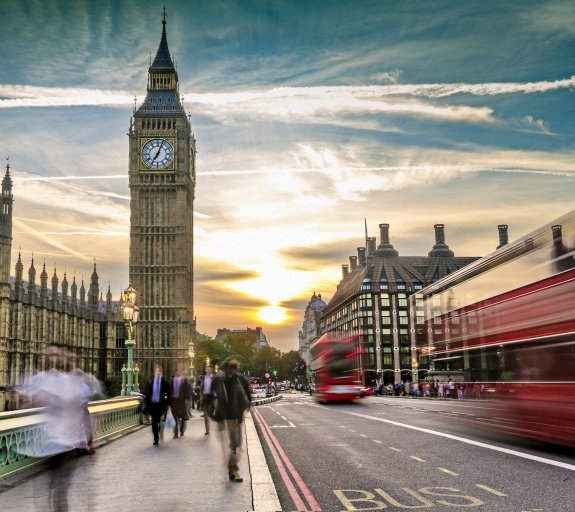
UK reaction: UK exits recession with better-than-expected GDP growth
KEY POINTS
The UK economy has rebounded strongly from last year’s recession, as rising real incomes encouraged households to increase spending and industrial production began to recover. Indeed, March’s 0.4% GDP increase drove a stronger-than-expected 0.6% quarter-on-quarter in the first quarter (Q1). Forecasters had expected a smaller 0.4% rise, after declines of 0.1% and 0.3% in Q3 and Q4 2023, respectively. Growth beat the Bank of England (BoE) Monetary Policy Committee’s upgraded forecast of 0.4% quarter-on-quarter and now looks set to outperform the BoE’s forecasts for the year. It is important to remember that this is a first estimate and therefore is subject to revisions, but GDP now looks set to increase by 0.6% this year, compared to our previous forecast, and the BoE’s, of 0.4%.
The stronger-than-expected monthly increase was largely driven by a 0.5% rise in services output, with 10 of the 14 subsectors growing in March. Consumer-facing services saw growth of 0.7%, following a 0.1% fall in February, as households switched spending towards food activities and accommodation. Production also increased on the month, driven by a 0.3% recovery in manufacturing output. The bumpy recovery in the manufacturing Purchasing Managers’ Index in recent months suggests this should broadly continue over the next few months. Construction, however, continued to fall, due to a decline in new work and repair and maintenance, as elevated borrowing costs continued to weigh on the sector.
Looking at the expenditure breakdown, the recovery in households’ consumption was a key driver, likely supported by the ongoing recovery in real incomes; it rose by 0.2% quarter-on-quarter after two consecutive quarters of decline. The recovery was broad-based, with households ramping up spending in most areas, including on housing, water and fuels. Overall, consumer-facing services grew by 0.6% in Q1, driven by retail sales, despite the wet weather. Strike action, meanwhile, continued to influence government spending. Junior doctors did not strike in March, following a five-day walkout in February, spurring a 1.1% monthly rebound in human health and social work activities. As a result, government expenditure rose by a further 0.3% in Q1, after a 0.1% rise in the previous quarter. Finally, gross fixed capital formation rose by 1.4% quarter-on-quarter, reflecting a 0.9% increase in real business investment.
A further recovery in real incomes - as pay growth continues to outpace CPI inflation and tax and benefit changes filter through – alongside rising confidence, falling interest rates and a fading mortgage hit, should support further increases in household consumption over the coming months. Today’s data also imply the household saving ratio edged down in Q1, given that nominal expenditure increased by 0.6% quarter-on-quarter, but employees’ compensation rose by a smaller 0.2%. While we don’t see a sharp drop, a further tick down will also support consumption.
Business investment, however, will likely hold broadly steady over the remainder of the year. Firms’ balance sheets are in pretty good shape but elevated borrowing costs will continue to make some projects unprofitable and businesses will probably want to wait to see the results of the General Election before going ahead. Overall, the strong start to the year means we have revised up our 2024 GDP forecast to 0.6% this year. Markets reacted modestly to the data, with sterling rising by 0.03% to $1.2536.
Disclaimer
This document is for informational purposes only and does not constitute investment research or financial analysis relating to transactions in financial instruments as per MIF Directive (2014/65/EU), nor does it constitute on the part of AXA Investment Managers or its affiliated companies an offer to buy or sell any investments, products or services, and should not be considered as solicitation or investment, legal or tax advice, a recommendation for an investment strategy or a personalized recommendation to buy or sell securities.
It has been established on the basis of data, projections, forecasts, anticipations and hypothesis which are subjective. Its analysis and conclusions are the expression of an opinion, based on available data at a specific date.
All information in this document is established on data made public by official providers of economic and market statistics. AXA Investment Managers disclaims any and all liability relating to a decision based on or for reliance on this document. All exhibits included in this document, unless stated otherwise, are as of the publication date of this document.
Furthermore, due to the subjective nature of these opinions and analysis, these data, projections, forecasts, anticipations, hypothesis, etc. are not necessary used or followed by AXA IM’s portfolio management teams or its affiliates, who may act based on their own opinions. Any reproduction of this information, in whole or in part is, unless otherwise authorised by AXA IM, prohibited.
Issued in the UK by AXA Investment Managers UK Limited, which is authorised and regulated by the Financial Conduct Authority in the UK. Registered in England and Wales No: 01431068. Registered Office: 22 Bishopsgate London EC2N 4BQ
In other jurisdictions, this document is issued by AXA Investment Managers SA’s affiliates in those countries.
© AXA Investment Managers 2024. All rights reserved



